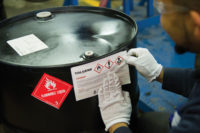
Flammable liquids can be a real nightmare because the codes are all over the map,” a plant manager told me. With regulations coming from so many sources, no wonder safety professionals have questions about storing these chemicals.
But you don’t have to lose sleep over it. Time spent reviewing OSHA’s standard can pay dividends in both compliance and safety. Other things you can do include:
- Understand what flammables are in your facility.
- Store all flammables properly.
- Control sources of ignition in those areas where flammables are used and stored.
- Properly mark your facility with “NO SMOKING” and “NO OPEN FLAME” signs.
- Train employees to work safely with the flammable liquids.
- Test your sprinkler system on a regular basis, and make sure that fire extinguishers are regularly checked.
Can flammable liquids be stored in plastic containers?
Flammable liquids must be kept in covered containers when not actually in use, and only approved containers and portable tanks may be used. This can mean DOT-approved shipping containers or containers “listed and labeled” with an approval from a nationally recognized testing laboratory (NRTL). OSHA’s Flammable and Combustible Liquids Standard, 29 CFR 1910.106, spells out the requirements for flammable liquid containers at 1910.106(d)(2)(i) and also in Table H-12, which describes an approved metal safety can.
An OSHA letter of interpretation dated 8/26/1996 says that plastic fuel cans may be used in some cases. It would, therefore, be a de minimus violation to store flammable liquids, like gasoline, in plastic containers that are DOT-approved but have a capacity of five gallons or less. OSHA determined that this storage method would pose very little hazard and still meet the basic intent of the standard.
Do flammable liquid storage cabinets have to be vented?
OSHA says nothing about exhaust ventilation. The NFPA 30 Flammable Liquids Handling and Storage Standard says that “…vent openings shall be sealed…” and “…if the storage cabinet is vented for any reason, the cabinet shall be vented direct to outdoors in such a manner…that is acceptable to the authority having jurisdiction.” The “authority having jurisdiction” is your local fire marshal or fire authorities.
What does OSHA say about disposing of oily rags?
OSHA states that combustibles are to be disposed of daily in covered metal receptacles. According to the Subpart E Appendix: “Certainly oil-soaked rags have to be treated differently than general paper trash in office areas.”
What is “incidental storage”?
Generally speaking, OSHA expects that all flammable and combustible liquids will be stored in a flammable storage cabinet, an inside storage room or a flammable storage warehouse. But there is an exemption for “incidental storage” at 1910.106(e)(2)(i), which allows the storage of up to 25 gallons of Class IA or 120 gallons of Class IB, IC, II or III in containers in any one “fire area” of a facility outside a flammable storage cabinet or storage room.
Can flammable and corrosive chemicals be stored in the same cabinet?
Each chemical’s material safety data sheet (MSDS) provides specific storage requirements and identifies incompatible materials that should not be stored together. You may store flammables and corrosives in the same cabinet, assuming that you store them in accordance with the manufacturer’s requirements and in approved containers.
What is “adequate ventilation”?
At 1910.106(a) OSHA says that ventilation is considered to be “adequate” if it is sufficient to prevent the accumulation of significant quantities of vapor-air mixtures in concentrations over one-fourth of the lower flammable limit. Flammable liquids give off ignitable vapors which, if mixed with air in the right ratio, will create a hazardous condition. There is a minimum concentration required for the vapors to burn, as well as a maximum concentration above which fire will not occur. In between these two end points, and when a source of ignition is introduced, rapid combustion or an explosion will result. This is called the “flammable” or “explosive limit” and is stated in an upper and lower percentage, such as Lower Flammable Limit (LFL).
An employer may also provide ventilation of one cubic foot per minute per square foot of solid floor area, as required under 1910.106(e)(3)(v). This would meet the requirements of 1910.106(e)(2)(iii), according to an OSHA letter of interpretation dated 12/26/2007. OSHA does caution that if an employer is required to have higher ventilation rates, such as under the air contaminant standard at 1910.1000, complying with 1910.106 does not relieve an employer of the responsibility for the higher ventilation rates.
Can gasoline-powered equipment, like lawn mowers, be stored inside of buildings?
Flammable liquids in the fuel tanks of portable engines like lawn mowers and weed trimmers are specifically exempt from coverage.
Do flammable liquid storage cabinets have to be grounded?
OSHA states at 1910.106(e)(6)(ii) that “Class I liquids shall not be dispensed into containers unless the nozzle and container are electrically interconnected.” The materials for OSHA’s Hazardous Materials course state that the requirement to ground flammable storage cabinets is found in NFPA 77 Recommended Practice on Static Electricity and not in any OSHA standard. Also, NFPA 33 Standard for Spray Application Using Flammable or Combustible Materials requires that metal objects in the vicinity of highly flammable liquids be grounded. Bonding and grounding of storage cabinets may also be a requirement of local or state fire codes.
Can water-reactive materials be stored with flammable liquids?
Both OSHA and NFPA hold that storage of water-reactive materials with flammable or combustible liquids in the same room or area constitutes an unreasonable hazard and risk.
